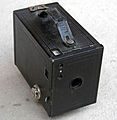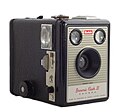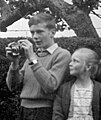Brownie (camera)
 Kodak Brownie No.2 Model F (1924) | |
| Overview | |
|---|---|
| Maker | Eastman Kodak |
| Type | box camera |
| Released | February 1900 |
| Production | Feb. 1900-Oct. 1901 |
| Intro price | $1 (equivalent to $31 in 2020) |
| Lens | |
| Lens | meniscus lens |
| Sensor/medium | |
| Film format | 117 roll film. |
| Film size | 2 1/4-inch square |
| Shutter | |
| Shutter | Integrated |
| General | |
| Body features | Leatherette covered cardboard |
| Made in | Rochester, NY |
| Chronology | |
| Successor | No. 2 Brownie (1901) |
| References | |
| Brownie (original model) | |
The Brownie was a series of cameras made by Eastman Kodak. Introduced in 1900,[1] it introduced the snapshot to the masses. It was a basic cardboard box camera with a simple meniscus lens that took 2 1/4-inch square pictures on 117 roll film. It was conceived and marketed for sales of Kodak roll films. Because of its simple controls and initial price of $1 (equivalent to $31 in 2020) along with the low price of Kodak roll film and processing, the Brownie camera surpassed its marketing goal.[2]
It was invented by Frank A. Brownell.[3] The name comes from the brownies (spirits in folklore) in Palmer Cox cartoons. Over 150,000 Brownie cameras were shipped in the first year of production.[4] An improved model, called No. 2 Brownie came in 1901, which produced larger 2-1/4 by 3-1/4 inch photos and cost $2 and was also a huge success.[2]
Brownies were extensively marketed to children, with Kodak using them to popularise photography. E They were also taken to war by soldiers. As they were ubiquitous, many iconic shots were taken on Brownies.[2]

The cameras continued to be popular, and spawned many varieties, such as a Boy Scout edition in the 1930s. In 1940, Kodak released the Six-20 Flash Brownie,[4] Kodak's first internally synchronized flash camera, using General Electric bulbs. In 1957, Kodak produced the Brownie Starflash, Kodak's first camera with a built-in flash.[4]
The Brownie 127 was popular,[5] selling in the millions between 1952 and 1967. It was a bakelite camera with a simple meniscus lens and a curved film plane to compensate for the deficiencies of the lens.[citation needed] Another model was the Brownie Cresta sold between 1955 and 1958. It used 120 film and had a fixed-focus lens.[6][7]
Having written an article in the 1940s for amateur photographers suggesting an expensive camera was unnecessary for quality photography, Picture Post photographer Bert Hardy used a Brownie camera to stage a carefully posed snapshot of two young women sitting on railings above a breezy Blackpool promenade.[8]
The last official Brownie camera made was the Brownie II Camera, a 110 cartridge film model produced in Brazil for one year, 1986.[9]
The Kodak Brownie Number 2 is a box camera that was manufactured by the Eastman Kodak Company from 1901 to 1935.[4] There were five models, A through F, and it was the first camera to use 120 film. It also came with a viewfinder and a handle.[10] The Brownie Number 2 was made of a choice of three materials: cardboard, costing US$2.00, aluminum, costing US$2.75, and a color model which cost US$2.50. It was a very popular and affordable camera, and many are still in use by film photographers.[11]
Gallery[]

Brownie No. 2 (1901–35)

No. 2 Folding Autographic Brownie 1915–26)

Beau Brownie camera (1930–33)
Hawkeye Brownie Flash Model (1950–61)

Brownie Flash III (1957–60)

Young photographer using a Brownie 127
References[]
- ^ List of Brownie models at George Eastman House Archived April 2, 2016, at the Wayback Machine
- ^ Jump up to: a b c Lothrop, Eaton S. “The Brownie Camera.” History of Photography 2, no. 1 (January 1978): 1–10. https://doi.org/10.1080/03087298.1978.10442948.
- ^ U.S. Patent 725,034
- ^ Jump up to: a b c d Gustavson, Todd (2011). 500 Cameras 170 years of photographic innovation. Sterling Signature. ISBN 978-1-4027-8086-8.
- ^ "Brownie 127"
- ^ "Brownie Cresta". The Brownie Camera Page. Retrieved 9 May 2021.
- ^ "Brace Yerself– The Kodak Brownie Cresta II Review". Canny Cameras. Retrieved 9 May 2021.
- ^ Bert Hardy snapshot
- ^ "Brownie II (110 Cartridge) The Last Brownie Camera". The Brownie Camera Page. Retrieved 9 May 2021.
- ^ Gustavson, Todd (2009). Camera A history of photography from Daguerreotype to Digital. Sterling Signature. ISBN 978-1-4027-5656-6.
- ^ "No.2 Brownie". The Brownie Camera Page. Retrieved 9 May 2021.
Further reading[]
- Dowling, Stephen (5 January 2015). "The most important cardboard box ever?". Retrieved 5 January 2014., gives history of the Brownie camera line
External links[]
| Wikimedia Commons has media related to Kodak Brownie. |
- U.S. Patent 725,034 Kodak Brownie, patented by Frank Brownell, filed July 1900
- The Brownie Camera @ 100: A Celebration on the Kodak website
- Kodak Brownie Target Six-20: A Review
- Kodak cameras
- 117 film cameras
- Cameras introduced in 1900
- Products introduced in 1952






